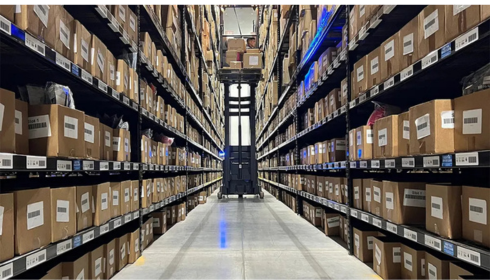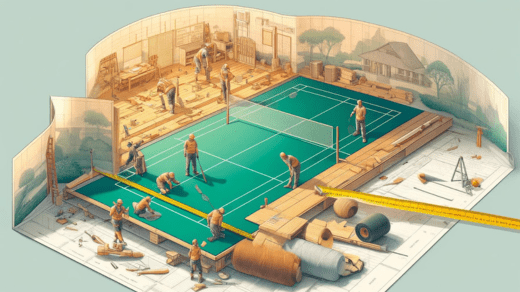Constructing a badminton court is an exciting endeavor that requires meticulous planning and execution. Whether you’re building a court for recreational use or as part of a larger facility, embarking on this project entails various steps that must be carefully followed to ensure a high-quality playing surface. In this guide, we will take you through a step-by-step process, from the initial planning stages to the completion of your badminton court. By following these guidelines, you can create a space that not only meets regulatory standards but also provides players with an enjoyable and safe environment to engage in the sport they love. Let’s dive in and explore the essential steps involved in constructing a synthetic badminton court, ensuring that every aspect is carefully considered to achieve optimal results.
Steps to Construct Badminton Court:
Constructing a badminton court requires careful planning and precise execution. Here’s a step-by-step guide to help you through the process:
Select a Suitable Location: Choose a flat area with enough space to accommodate a badminton court, preferably with minimal obstructions such as trees or buildings.
Measure the Dimensions: A standard badminton court measures 20 feet in width for doubles 17 feet for singles, and 44 feet in length. Mark these dimensions clearly on the ground.
Prepare the Ground: Clear any debris or vegetation from the area. Ensure that the ground is level and compacted properly to provide a stable base.
Mark the Court Boundaries: Use chalk or paint to mark the boundaries of the court according to the dimensions mentioned earlier. Ensure the lines are straight and accurately placed.
Install Boundary Lines: Once the boundaries are marked, install boundary lines using tapes or ropes. These lines define the playable area of the court.
Construct Poles and Net: Install poles at both ends of the court to support the net. The poles should be securely anchored into the ground and positioned at a height of 5 feet 1 inch (1.55 meters) above the ground level. Hang the net between the poles, ensuring it is taut and at the correct height of 5 feet (1.524 meters) at the center.
Surface Preparation: If you’re constructing an outdoor court, consider surfacing options such as synthetic surfaces. Pacecourt provides the best synthetic surface materials. Ensure the surface is smooth, non-slippery, and suitable for badminton play.
Mark the Service Courts: Within the overall court boundaries, mark the service courts. These are located 6 feet 6 inches (1.98 meters) from the net for doubles and 5 feet 1 inch (1.55 meters) for singles. These service courts should be marked clearly with lines perpendicular to the net.
Why Choose Pacecourt Materials for Badminton Court Construction
When it comes to constructing a badminton court, selecting the right materials is paramount to achieving a high-quality playing surface that meets the needs of players and facility owners alike. Pacecourt materials stand out as an excellent choice for badminton court construction due to several compelling reasons:
Superior Durability: Pacecourt materials are engineered with high-quality components that ensure exceptional durability, capable of withstanding the rigors of heavy use and frequent gameplay without deteriorating. This longevity ensures that your badminton court remains in optimal condition for years to come, minimizing the need for frequent repairs or replacements.
Consistent Performance: Pacecourt materials offer consistent performance characteristics, including traction, ball bounce, and shock absorption. This consistency ensures a reliable and predictable playing experience for players of all skill levels, allowing them to focus on their game without worrying about surface inconsistencies.
Customization Options: Pacecourt materials provide a range of customization options, allowing you to tailor your badminton court to meet your specific preferences and requirements. Whether you prefer a traditional hardwood surface or a modern synthetic material, Pacecourt offers the flexibility to create a court that aligns with your vision.
Low Maintenance Requirements: Pacecourt materials require minimal maintenance compared to other surface options, saving you time and resources in the long run. With easy cleaning and occasional upkeep, Pacecourt surfaces retain their appearance and performance over time, reducing the hassle and cost associated with maintenance.
Eco-Friendly Practices: Pacecourt is committed to sustainability, utilizing eco-friendly materials and manufacturing processes that minimize environmental impact. By choosing Pacecourt materials for your badminton court construction, you can contribute to a greener future while enjoying a top-quality playing surface.
Conclusion:
In conclusion, choosing Pacecourt materials for your badminton court construction project is a decision that promises exceptional quality, performance, and sustainability. With superior durability, consistent performance, customization options, low maintenance requirements, and eco-friendly practices, Pacecourt stands out as the ideal choice for creating a top-tier playing surface. By selecting Pacecourt materials, you can ensure that your badminton court meets the highest standards of quality and durability, providing players with a reliable and enjoyable playing experience for years to come. Additionally, Pacecourt’s commitment to sustainability ensures that your construction project aligns with environmental values, contributing to a greener future.






